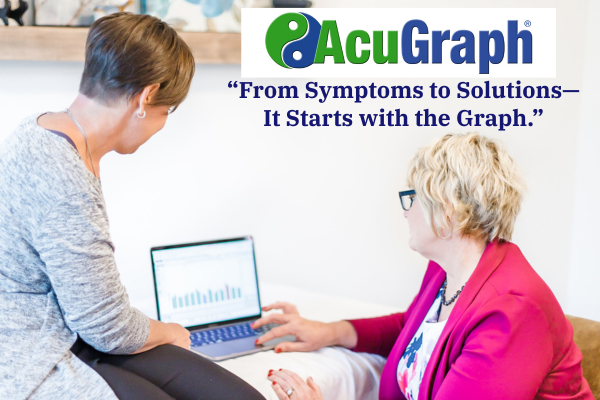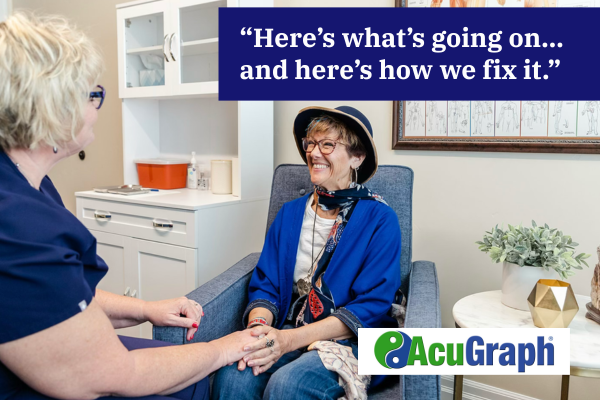Unlocking the Real Power of AcuGraph through Patient Education
Hi, I’m Dr. Kimberly Thompson.
Healer. Teacher. Mentor.
And I’m an expert in patient education with AcuGraph—because helping patients understand their graph is just as important as interpreting it yourself.
I’m sure you have seen me teaching acupuncturists how to interpret AcuGraph results, understand the pathways, and build treatment strategies that get results.
But here’s something you might not realize: I work just as hard teaching my patients!—because here’s the truth:

The graph doesn’t lie.
But if you’re not telling the whole story, your patients aren’t learning anything. And when patients don’t understand, they don’t come back.
🛑 Stop Saying “Your Liver Is Out of Balance” and Start Telling the Real Story
Your patients don’t need you to sound like an ancient Chinese textbook; they need you to help them connect the dots.
Here’s how it looks in my clinic:
✅ We graph the patient.
✅ We talk about their symptoms in relation to the graph.
✅ We create a treatment plan—together.
Simple. Direct. Educational.

I’ve spent the last 17 years learning how to talk to patients about acupuncture, and here’s what I’ve learned:
Patients don’t care about “Spleen Qi Deficiency” or “Liver Yang Rising.”
They just want to know:
👉 What’s wrong with me?
👉 Can you help me?
The answer? Yes. Absolutely.
After treatment, they ask the next obvious question:
👉 How do I keep feeling this good?
And the answer to that one?
Learn to listen to your body.
Teaching patients to listen starts at the consultation.
Their body’s angry. They seek acupuncture.
You graph them. You show them the problem. You treat them.
Their symptoms start to melt away.
(80% of the time, it’s that simple.)
Patients are amazed.
And they don’t forget.
But here’s the part that really matters:
It’s not the graph that keeps them coming back…
It’s how well you tell the story of what their body is trying to say.
Are You Telling the Whole Story?
Not just “Your Liver is out of balance.”
Not just “Your Spleen is excess.”
What does it really mean when a patient feels tired, bloated, anxious, restless, or stuck?
When patients understand the story—their story—they trust you to help write the next chapter.
💡The Cheat Sheet I Wish I Had Years Ago
I love teaching. I love mentoring. I love creating tools that make this work easier—for you and for your patients.
That’s why I created this simple cheat sheet—to help make conversations about symptoms, pathways, and treatment plans quick, clear, and confident.
And now I’m sharing it with you.
It’s a quick-reference guide to help you connect general symptoms and emotions to the 12 acupuncture pathways—without sounding like a textbook.
Whether you’re new to AcuGraph or have been using it for years, Dr. Kimberly’s Acupuncture Pathway Cheat Sheet is designed to make communication easier for both you and your patients.
Perfect for:
✔️ Your treatment room
✔️ New patient folders
✔️ Refreshing your own confidence
CLICK HERE to download:
“Dr. Kimberly’s Acupuncture Pathway Cheat Sheet”
How to Talk Symptoms with Confidence
Teaching Is How We Build Trust
How are YOU teaching your patients to listen to their bodies?
Are you using emails, blogs, or social media to help them understand the pathways?
Send me your social links—I’d love to follow along and cheer you on.
Let’s keep learning, teaching, and inspiring—together.
Cheers,
~Dr. Kimberly
Curious if AcuGraph is right for your practice?
Book a free, no-pressure consultation with Dr. Larsen
Get clear answers, expert insight, and zero sales pressure.
Thank you so much for this cheat sheet! I’m sure it will help me gobs in explaining any patient situation with confidence. You are amazing, Dr Kimberly!
Great stuff-thanks for sharing! The 5 days I spent with you in your clinic changed my life-and my practice-thank you thank you thank you
A clear, practical tool that helps me educate and empower my clients. Great resource! Thank you Dr. Kimberly for continuing to inspire us — and for helping us inspire our patients too.